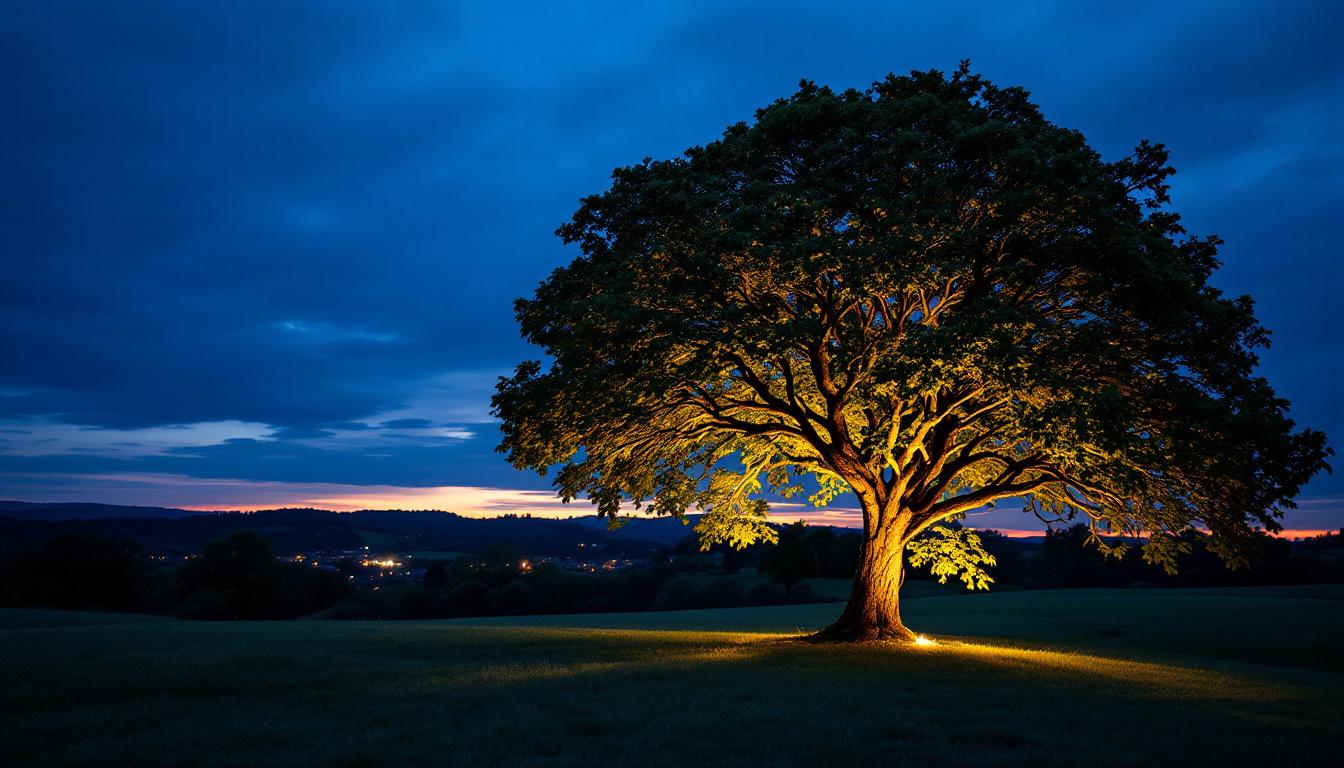
Lighting plays a crucial role in enhancing the beauty and functionality of outdoor spaces, especially when it comes to landscaping. Among the various techniques available, tree spot lighting stands out as a method that not only highlights the natural beauty of trees but also adds depth and character to the overall landscape. For lighting contractors, mastering the art of tree spot lighting can significantly elevate their service offerings. This article delves into proven methods and best practices for effective tree spot lighting.
Tree spot lighting involves the strategic placement of lights to illuminate trees, creating a stunning visual effect at night. This technique can transform a mundane outdoor area into a magical landscape, showcasing the unique shapes and textures of trees. It also serves practical purposes, such as improving safety and visibility in outdoor spaces. By highlighting the natural beauty of trees, spot lighting can create an enchanting atmosphere that enhances outdoor gatherings, celebrations, or simply a quiet evening at home.
When executed correctly, tree spot lighting can accentuate the natural features of a tree, such as its trunk, branches, and foliage. The right lighting can create dramatic shadows, highlight the tree’s structure, and even enhance the surrounding landscape. For lighting contractors, understanding the fundamentals of this technique is essential to delivering exceptional results to clients. Additionally, the interplay of light and shadow can evoke different moods, from serene and tranquil to vibrant and lively, depending on the placement and intensity of the lights.
Implementing tree spot lighting comes with numerous advantages. Firstly, it enhances the aesthetic appeal of a property, making it more inviting and visually appealing. Well-lit trees can serve as focal points in a garden or yard, drawing attention and admiration. This can be particularly beneficial for properties that host events or have outdoor entertaining spaces, as beautifully illuminated trees can create a warm and welcoming ambiance for guests.
Secondly, tree spot lighting improves safety and security. Illuminating pathways and outdoor areas can deter potential intruders and reduce the risk of accidents. Homeowners are likely to feel more secure in well-lit spaces, making tree spot lighting a practical investment. Furthermore, well-lit outdoor areas can extend the usability of a property, allowing families to enjoy their gardens and yards long after sunset, whether for evening barbecues, children’s playtime, or simply relaxing under the stars.
To achieve effective tree spot lighting, selecting the appropriate fixtures and equipment is vital. Lighting contractors should consider various factors, including the type of light source, fixture design, and installation methods. LED lights are often recommended due to their energy efficiency, longevity, and versatility. They produce less heat than traditional bulbs, which can be beneficial for preserving the health of the trees being illuminated.
Additionally, the choice of fixtures can significantly impact the quality of light produced. Spotlights, floodlights, and well lights each offer different effects and should be chosen based on the desired outcome. Understanding the nuances of each type will enable contractors to make informed decisions that align with their clients’ needs. Moreover, it’s essential to consider the color temperature of the lights; warmer tones can create a softer, more inviting atmosphere, while cooler tones can provide a more modern and crisp look. By carefully selecting the right equipment, contractors can ensure that the lighting complements the natural beauty of the trees and the overall landscape design.
A well-thought-out lighting design is essential for successful tree spot lighting. This involves assessing the landscape, identifying key trees to spotlight, and determining the best angles for illumination. Proper planning will ensure that the lighting enhances the natural beauty of the trees while avoiding unwanted glare or shadows.
Before any installation, a thorough site assessment should be conducted. This includes evaluating the size, shape, and location of the trees, as well as considering the surrounding environment. Factors such as nearby structures, existing light sources, and the overall landscape layout will influence the lighting design.
Contractors should take note of the tree’s growth patterns and seasonal changes, as these will affect the lighting’s effectiveness throughout the year. Additionally, understanding the client’s preferences and the intended use of the outdoor space will guide the design process.
Choosing the right angle for lighting is crucial in achieving the desired effect. There are several techniques that lighting contractors can employ, including uplighting, downlighting, and moonlighting. Each technique offers a unique perspective and can create different moods within the landscape.
Uplighting, for instance, involves placing lights at the base of the tree and directing them upward, creating a dramatic effect that highlights the tree’s height and structure. Conversely, downlighting mimics natural moonlight, casting a soft glow from above to illuminate the ground below. Moonlighting can enhance the ambiance of outdoor gatherings while providing functional lighting for pathways.
Once the design is finalized, the installation process can begin. Proper installation is critical to ensure the longevity and effectiveness of the lighting system. Lighting contractors should adhere to best practices during this stage to achieve optimal results.
Positioning the fixtures correctly is essential for effective tree spot lighting. Contractors should consider the height and spread of the tree’s branches when determining where to place the lights. Ideally, fixtures should be positioned at a distance that allows for even illumination without creating harsh shadows.
In many cases, placing lights 10 to 15 feet away from the tree can provide the best results. However, this distance may vary based on the tree’s size and the desired lighting effect. Experimentation during the installation process can help contractors find the perfect balance between light intensity and coverage.
Ensuring a safe and reliable power supply is paramount in any lighting installation. Contractors should follow local electrical codes and regulations when running wiring for the lighting system. Using low-voltage systems can minimize risks and reduce energy consumption, making them a popular choice for outdoor lighting.
Additionally, using weather-resistant materials and fixtures will help protect the lighting system from the elements, ensuring its longevity. Properly securing and concealing wiring will not only enhance the aesthetic appeal but also reduce the risk of damage or accidents.
Regular maintenance is essential to keep tree spot lighting systems functioning optimally. Lighting contractors should educate clients on the importance of routine checks and maintenance to ensure the longevity of their investment.
Conducting routine inspections can help identify potential issues before they escalate. Contractors should recommend checking the fixtures for any signs of wear or damage, as well as ensuring that the light bulbs are functioning correctly. Cleaning the fixtures periodically can also enhance their performance and brightness.
Additionally, checking the wiring and connections for any signs of corrosion or fraying is crucial. Addressing these issues promptly will help maintain the safety and effectiveness of the lighting system.
Even with regular maintenance, issues may arise from time to time. Lighting contractors should be prepared to troubleshoot common problems, such as flickering lights, inconsistent brightness, or complete outages. Understanding the underlying causes can help contractors provide effective solutions.
For instance, flickering lights may indicate a loose connection or a failing bulb, while inconsistent brightness could be due to voltage fluctuations. By diagnosing these issues accurately, contractors can ensure that clients receive prompt and effective service.
Delivering exceptional tree spot lighting services goes beyond installation; it also involves ensuring client satisfaction. Lighting contractors should focus on building strong relationships with clients by providing quality service and support throughout the process.
Effective communication is key to understanding client needs and expectations. Contractors should take the time to discuss design options, lighting techniques, and potential challenges with clients. This collaborative approach fosters trust and ensures that clients feel valued throughout the project.
Providing clients with detailed explanations of the installation process, maintenance requirements, and potential outcomes will empower them to make informed decisions. Transparency in communication can lead to higher satisfaction rates and increased referrals.
Offering aftercare services can further enhance client satisfaction. Providing clients with a maintenance schedule or offering periodic check-ups can demonstrate a commitment to their investment. This proactive approach can help prevent issues and ensure that the lighting system continues to perform optimally.
Additionally, contractors can offer recommendations for seasonal adjustments or upgrades to keep the lighting system fresh and relevant. By staying engaged with clients even after the installation, contractors can build long-lasting relationships and encourage repeat business.
Tree spot lighting is a powerful technique that can transform outdoor spaces and enhance the beauty of landscaping. For lighting contractors, mastering this art involves understanding the principles of effective design, installation, and maintenance. By employing proven methods and best practices, contractors can deliver exceptional results that not only meet but exceed client expectations.
From selecting the right equipment to planning the lighting design and ensuring proper installation, every step plays a crucial role in achieving stunning outcomes. By focusing on client satisfaction and maintaining strong communication, lighting contractors can establish themselves as trusted experts in the field of outdoor lighting.
In an industry that continually evolves, staying informed about the latest trends and technologies will further enhance a contractor’s ability to deliver high-quality services. Embracing innovation while adhering to proven methods will ensure that tree spot lighting remains a sought-after service in the competitive landscape of outdoor lighting.
Ready to elevate your tree spot lighting projects and impress your clients with exceptional results? At LumenWholesale, we provide you with the spec-grade lighting products you need to shine in the competitive landscape of outdoor lighting. Our commitment to quality, affordability, and convenience ensures that you have access to the best lighting solutions on the market. Say goodbye to inflated markups and hello to unbeatable wholesale prices, free shipping, and the reliability that comes with our industry-standard selection. Take the first step towards transforming outdoor spaces with premium lighting by visiting Wholesale Lighting at the Best Value today.

Discover innovative strategies and insights from top lighting contractors on integrating Feit T12 Buizz into smart lighting solutions.

Discover expert tips and best practices for converting 4-inch deep canned lights, tailored specifically for lighting contractors.

Discover innovative strategies for boosting profitability in lighting installations with Recrytacle.

Discover essential tips and best practices for lighting contractors when selecting and installing LED bulbs for recessed lighting.